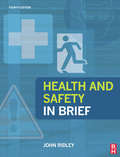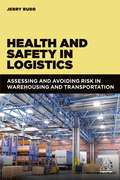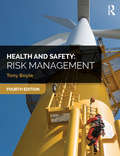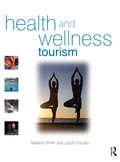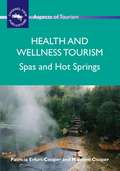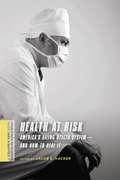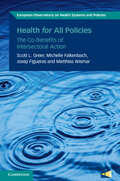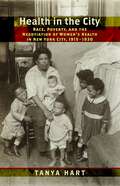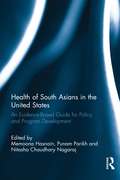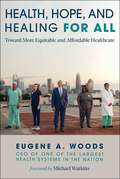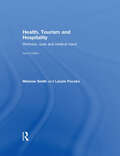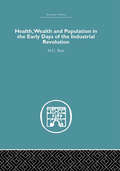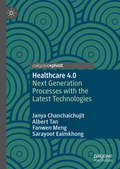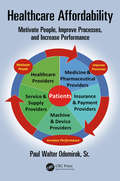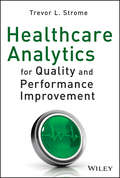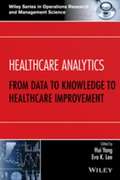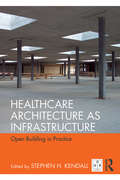- Table View
- List View
Health and Safety in Brief (Made Simple Bks.)
by John RidleyIn plain English, John Ridley guides the reader through Health and Safety legislation and explains how to comply with it in practical terms. The text is clearly laid out, distinguishing between bulleted summaries of legislative requirements and the author's advice and commentary.By condensing the fundamental contents of the author's acclaimed Safety at Work into a practical and affordable volume, Health and Safety in Brief has established itself as a valuable handbook for safety representatives and managers, as well as an essential revision aid for students on introductory health & safety and general management courses such as: * NEBOSH National Certificate and Diploma in Occupational Safety and Health* IOSH Managing Safely* CIEH Advanced Certificate in Health & Safety in the Workplace * British Safety Council Level 3 Certificate in Occupational Safety and Health * NVQs in Occupational Safety and Health * Chartered Management Institute's Level 5 Diploma in ManagementNew in this edition:* Completely revised coverage of fire safety in line with Regulatory Reform (Fire Safety) Order* Construction safety incorporates new Construction (Design and Management) Regulations 2007 and new Working at Heights Regulations* Coverage of changes in employment law, including age discrimination and working time* More on the effects of the Woolf Report
Health and Safety in Canadian Workplaces
by Bob Barnetson Jason FosterWorkplace injuries happen every day and can profoundly affect workers, their families, and the communities in which they live. This textbook is for workers and students looking for an introduction to injury prevention on the job. It offers an extensive overview of central occupational health and safety (OHS) concepts and practices and provides practical suggestions for health and safety advocacy. Foster and Barnetson bring the field into the twenty-first century by including discussions of how precarious employment, gender, and ill-health can be better handled in Canadian OHS. Although they address the gendered and racialized dimensions of new work processes and structures in contemporary workplaces, Foster and Barnetson contend that the practice of occupational health and safety can only be understood if we acknowledge that workers and employers have conflicting interests. Who identifies what workplace hazards should be controlled is therefore a product of the broader political economy of employment and one that should be well understood by those working in the field.
Health and Safety in Logistics: Assessing and Avoiding Risk in Warehousing and Transportation
by Jerry RuddLogistics is a complex industry that exposes employees to a whole variety of risks. These include not only accidents on the road and deaths and injuries resulting from unsafe use of forklifts, but also the consequences of poor fire safety, long-term health risks due to poor manual handling technique and problems relating to mental health. Many thousands of incidents are recorded every year. This book examines each aspect of health and safety in turn, with a focus on warehousing and transportation.Health and Safety in Logisticsinforms managers about potential hazards found in the industry and explains in detail how they can make the workplace as safe as possible.
Health and Safety: Risk Management
by Tony Boyle Fiona CharltonHealth and Safety: Risk Management is the clearest and most comprehensive book on risk management available today. This newly revised sixth edition takes into account new developments in legislation, standards and good practice. ISO 45001, the international health and safety management system standard, is given comprehensive treatment together with the guidance in ISO 45002. The latest ISO 10013 has also been addressed, however, ISO 45003 on psychosocial risk has been dealt with in a companion volume, Well-being and Wellness: Psychosocial Risk Management also by Boyle and Charlton.The book is divided into four main parts. Part 1.1 begins with a basic introduction to the techniques of health and safety risk management and continues with a description of ISO 45001. Part 1.2 covers basic human factors including how the sense organs work and the psychology of the individual. Part 2.1 deals with more advanced techniques of risk management including advanced incident investigation, audit and risk assessment, and Part 2.2 covers a range of advanced human factors topics including human error and decision making.This authoritative treatment of health and safety risk management is essential reading for both students working towards degrees, diplomas and postgraduate or vocational qualifications, and experienced health and safety professionals, who will find it invaluable as a reference.
Health and Safety: Risk Management
by Tony BoyleHealth and Safety: Risk Management is the clearest and most comprehensive book on risk management available today. This newly revised fourth edition integrates new developments in legislation, standards and practice, and incorporates up-to-date information for qualification syllabuses. The book is divided into four main parts. Part 1.1 is primarily concerned with the fundamentals of risk management and is relevant for all students of health and safety, while Part 1.2 covers the required basic human factors material required for health and safety qualifications. Part 2.1 deals with the more advanced aspects of risk management, while Part 2.2 covers the more advanced human factors material required by those studying for qualifications in health and safety. This authoritative treatment of risk management is essential reading for both students working towards degrees, diplomas and postgraduate or vocational qualifications in health and safety and experienced health and safety professionals, who will find it invaluable as a reference.
Health and Safety: Risk Management
by Tony BoyleHealth and Safety: Risk Management is the clearest and most comprehensive book on risk management available today. This newly revised fifth edition takes into account new developments in legislation, standards and good practice. ISO 45001, the international health and safety management system standard, is given comprehensive treatment, and the latest ISO 9004 and ISO 19011 have also been addressed. The book is divided into four main parts. Part 1.1 begins with a basic introduction to the techniques of health and safety risk management and continues with a description of ISO 45001. Part 1.2 covers basic human factors including how the sense organs work and the psychology of the individual. Part 2.1 deals with more advanced techniques of risk management including advanced incident investigation, audit and risk assessment, and Part 2.2 covers a range of advanced human factors topics including human error and decision making. This authoritative treatment of health and safety risk management is essential reading for both students working towards degrees, diplomas and postgraduate or vocational qualifications, and experienced health and safety professionals, who will find it invaluable as a reference.
Health and Wellness Tourism
by Melanie Smith Laszlo PuczkoHealth and Wellness Tourism takes an innovative look at this rapidly growing sector of today’s thriving tourism industry. This book examines the range of motivations that drive this diverse sector of tourists, the products that are being developed to meet their needs and the management implications of these developments.A wide range of international case studies illustrate the multiple aspects of the industry and new and emerging trends including spas, medical wellness, life-coaching, meditation, festivals, pilgrimage and yoga retreats. The authors also evaluate marketing and promotional strategies and assess operational and management issues in the context of health and wellness tourism.This text includes a number of features to reinforce theory for advanced students of hospitality, leisure and tourism and related disciplines.
Health and Wellness Tourism
by Malcolm Cooper Patricia Erfurt-CooperGeothermal springs constitute a major tourism resource, providing spectacular settings, recreation facilities, a recognised value in treatments beneficial for health and wellness, a sense of heritage and adventure, and links with the natural environment. Health and wellness tourism accounts for a significant proportion of the world's tourism consumption, with components ranging from hot spring bathing for leisure and recreation, through mineral water use in health treatments under the supervision of highly specialised medical professionals, to water treatments in the wellness and beauty therapy sector and the use of mineral water for drinking purposes. This makes it an economically and socially important area of tourism demanding in-depth analysis. This book explores health and wellness tourism from a range of perspectives including usage, heritage, management, technology, environmental and cultural features, and marketing.
Health at Risk: America's Ailing Health System--and How to Heal It
by Jacob S. HackerIn this volume, the nation's leading advisors on health policy and financing appraise America's ailing healthcare system and suggest reasonable approaches to its rehabilitation. Each chapter confronts a major challenge to the country's health security, from runaway costs and uneven quality of care to declining levels of insurance coverage, medical bankruptcy, and the growing enthusiasm for health plans that put patients in charge of risk and cost. Bringing the latest research to bear on these issues, contributors diagnose the problems of our present system and offer treatments grounded in extensive experience. Free of bias and rhetoric, Health at Risk is an invaluable tool for those who are concerned with the current state of healthcare and are eager to effect change.
Health for All Policies: The Co-Benefits of Intersectoral Action (European Observatory on Health Systems and Policies)
by Scott L. Greer Matthias Wismar Josep Figueras Michelle FalkenbachFactors outside of healthcare services determine our health and this involves many different sectors. Health for All Policies changes the argument about inter-sectoral action, from one focusing on health and the health sector to one based on co-benefits – a 'Health for All Policies' approach. It uses the Sustainable Development Goals as the framework for identifying goals across sectors and summarizes evidence along two causal axes. One is the impact of improved health status on other SDGs, e.g. better educational and employment results. The other is the impact of health systems and policies on other sectors. The 'Health for All Policies' approach advocated in this book is thus a call to improve health to achieve goals beyond health and for the health sector itself to do better in understanding and directing its impact on the world beyond the healthcare it provides. This title is also available as Open Access on Cambridge Core.
Health in the City: Race, Poverty, and the Negotiation of Women’s Health in New York City, 1915–1930 (Culture, Labor, History #9)
by Tanya HartShortly after the dawn of the twentieth century, the New York City Department of Health decided to address what it perceived as the racial nature of health. It delivered heavily racialized care in different neighborhoods throughout the city: syphillis treatment among African Americans, tuberculosis for Italian Americans, and so on. It was a challenging and ambitious program, dangerous for the providers, and troublingly reductive for the patients. Nevertheless, poor and working-class African American, British West Indian, and Southern Italian women all received some of the nation's best health care during this period. Health in the City challenges traditional ideas of early twentieth-century urban black health care by showing a program that was simultaneously racialized and cutting-edge. It reveals that even the most well-meaning public health programs may inadvertently reinforce perceptions of inferiority that they were created to fix.
Health of South Asians in the United States: An Evidence-Based Guide for Policy and Program Development
by Memoona Hasnain Punam Parikh Nitasha Chaudhary NagarajLeading scholars and practitioners come together in this contributed volume to present the most current evidence on cutting edge health issues for South Asian Americans, the fastest growing Asian American population. The book spans a variety of health topics while examining disparities and special health needs for this population. Subjects discussed include: cancer, obesity, HIV/AIDS, women's health, LGBTQ health and mental health. Health of South Asians in the United States presents research-based recommendations to help determine priorities for prevention, diagnosis, treatment, education, and policies which will optimize the health and well-being of South Asian American communities in the United States. Although aimed at both students, healthcare professionals and policy makers, this book will prove to be useful to anyone interested in the health and well-being of the South Asian communities in the United States.
Health, Economic Development and Household Poverty: From Understanding to Action (Routledge International Studies in Health Economics #Vol. 5)
by Sara Bennett Lucy Gilson Anne MillsAccessible and edited by authors based at a top institution, this book provides readers with an excellent summary in an easy-to-read style of this burgeoning field of research. In this volume Bennett, Gilson and Mills have gathered together essays written by academics and experts in the fields of health policy and economic development, each underscoring the need for political commitment to meet the needs of the poor and the development of strategies to build this commitment, covering: evidence regarding the links between health, economic development and household poverty evidence on the extent to which health care systems address the needs of the poor and the near poor innovative measures to make health care interventions widely available to the poor. Current and topical, this book is of great relevance to policy makers and practitioners in the field of international health and development and researchers engaged with global health and poverty as well as being ideal reading for students of international health and development.
Health, Hope, and Healing for All: Toward More Equitable and Affordable Healthcare
by Eugene A. WoodsOne of America&’s top healthcare leaders offers a prescription to fix an ailing and inequitable healthcare system In Health, Hope, and Healing for All, Eugene A. Woods, CEO of Advocate Health, one of the largest non-profit health systems in the nation, provides a riveting behind-the-scenes look at healthcare in the United States. By sharing his insights from three decades in healthcare administration, as well as his personal journey, readers gain a deeper understanding of the challenges facing healthcare systems and the impact on all of us. Woods sheds light on the inequities our communities face, especially in the context of the COVID-19 pandemic, and presents actionable prescriptions to create a more equitable, just and accessible healthcare system. He tackles tough questions around the affordability of healthcare, rising drug prices, alarming clinical shortages and more. As a Black healthcare CEO, Woods shares his personal experiences with injustice and charts a path towards meaningful change. His optimistic outlook and passion for transformation and innovation inspire readers to believe in the power of unity and resilience in the face of adversity.Health, Hope, and Healing for All is a must-read for those working in healthcare, policymakers, and individuals seeking hope and answers in an uncertain healthcare landscape. Supported by Woods' expertise and credibility, the book presents real solutions to the current crisis and highlights the urgent need to ensure accessible, affordable and compassionate healthcare for every American.
Health, Tourism and Hospitality: Spas, Wellness and Medical Travel
by Melanie Smith Laszlo PuczkoHealth, Tourism and Hospitality: Spas, Wellness and Medical Travel, 2nd Edition takes an in-depth and comprehensive look at the growing health, wellness and medical tourism sectors in a global context. The book analyses the history and development of the industries, the way in which they are managed and organised, the expanding range of new and innovative products and trends, and the marketing of destinations, products and services. The only book to offer a complete overview and introduction to health, tourism and hospitality this 2nd Edition has been updated to include: * Expanded coverage to the hospitality sector with a particular focus on spa management.* New content on medical tourism throughout the book, to reflect the worldwide growth in medical travel with more and more countries entering this competitive market.* Updated content to reflect recent issues and trends including: ageing population, governments encouraging preventative health, consumer use of contemporary and alternative therapies, self-help market, impacts of economic recession, spa management and customer loyalty.* New case studies taken from a range of different countries and contexts, and focusing on established or new destinations, products and services such as: conventional medicine, complementary and alternative therapies, lifestyle-based wellness, beauty and cosmetics, healthy nutrition, longevity and anti (or active)-ageing, amongst others. Written in a user friendly style, this is essential reading for students studying health, tourism and hospitality.
Health, Tourism and Hospitality: Spas, Wellness and Medical Travel
by Melanie Smith Laszlo PuczkoHealth, Tourism and Hospitality: Spas, Wellness and Medical Travel, 2nd Edition takes an in-depth and comprehensive look at the growing health, wellness and medical tourism sectors in a global context. The book analyses the history and development of the industries, the way in which they are managed and organised, the expanding range of new and innovative products and trends, and the marketing of destinations, products and services. The only book to offer a complete overview and introduction to health, tourism and hospitality this 2nd Edition has been updated to include: • Expanded coverage to the hospitality sector with a particular focus on spa management.• New content on medical tourism throughout the book, to reflect the worldwide growth in medical travel with more and more countries entering this competitive market.• Updated content to reflect recent issues and trends including: ageing population, governments encouraging preventative health, consumer use of contemporary and alternative therapies, self-help market, impacts of economic recession, spa management and customer loyalty.• New case studies taken from a range of different countries and contexts, and focusing on established or new destinations, products and services such as: conventional medicine, complementary and alternative therapies, lifestyle-based wellness, beauty and cosmetics, healthy nutrition, longevity and anti (or active)-ageing, amongst others.Written in a user friendly style, this is essential reading for students studying health, tourism and hospitality.
Health, Wealth and Population in the Early Days of the Industrial Revolution
by M.C. BuerFirst Published in 2005. Routledge is an imprint of Taylor & Francis, an informa company.
HealthCare.gov: The Crash and the Fix (A)
by Leonard A. Schlesinger Paras D. BhayaniA review of the process utilized by the Obama administration to create the Health Care.gov exchange and the problems that resulted from the implementation effort. There is a B case that provides the follow on strategy and processes utilized to get the site up and running after the initial failures of implementation.
HealthCare.gov: The Crash and the Fix (B)
by Leonard A. Schlesinger Paras D. BhayaniA review of the process utilized by the Obama administration to create the Health Care.gov exchange and the problems that resulted from the implementation effort. This case provides the follow on strategy and processes utilized to get the site up and running after the initial failures of implementation.
Healthcare 4.0: Next Generation Processes with the Latest Technologies
by Janya Chanchaichujit Albert Tan Fanwen Meng Sarayoot EaimkhongThis book aims to demonstrate the benefits of implementing Industry 4.0 in healthcare services and to recommend a framework to support this implementation. Key topics in this book include: (1) Discovering emerging technologies and techniques to support Healthcare 4.0, this includes the Internet of Things (IOT) , Big data analytics, Blockchain, Artificial Intelligence (AI) , Optimisation and Predictive Analytics; (2) Illustrating some examples of such advanced implementation in Healthcare 4.0; (3) Recommending a development process to develop health technology start-ups and entrepreneurial activities; and (4) Discuss the transformation methodology used to redesign healthcare processes in order to overcome the challenges of implementing a Healthcare 4.0 project.
Healthcare Affordability: Motivate People, Improve Processes, and Increase Performance (Continuous Improvement Series)
by Paul Walter Odomirok, Sr.Healthcare Affordability: Motivate People, Improve Processes, and Increase Performance applies the Theory of Affordability across the Healthcare Enterprise. Affordability is realized when the Value delivered exceeds the Patient’s requirements, while the expense for the quality resources required to deliver that Value is at a Cost less than the revenue received from the competitive pricing applied to the care. The aim of healthcare affordability is to attain performance excellence in all areas across the entire Healthcare Enterprise. The Healthcare Enterprise involves 5 types of providers: Healthcare Providers, Medicine and Pharmaceutical Providers, Machine and Device Providers, Service and Supplier Providers, and Insurance and Payment Providers. Obviously, one key focal point of healthcare affordability is affordable healthcare, a condition that has been chased for decades, but has yet to be achieved. This book provides a useful framework and foundation for any organization to pursue and achieve Affordability. Although there are many methods used to accomplish performance improvement, this approach has been proven successful with many organizations. It integrates strategic vision and direction, with operational goals and objectives and tactical targets and tasks. This book also provides a leadership strategy and structure for change and transformation, and a designed plan to execute an 18-month implementation program. Features: Affords patients and providers a better, faster, safer, and more affordable and profitable experience and approach Offers solutions for current state dilemmas, and provides a framework for future state success Increases the speed of delivery, improves the quality, and decreases the cost of care Provides methods and tools for linking and integrating strategic, operational and tactical goals Healthcare Affordability: Motivate People, Improve Processes, and Increase Performance provides readers with methods and means for solving the complex problem of affordable healthcare.
Healthcare Analytics for Quality and Performance Improvement
by Trevor L. StromeImprove patient outcomes, lower costs, reduce fraud--all with healthcare analytics Healthcare Analytics for Quality and Performance Improvement walks your healthcare organization from relying on generic reports and dashboards to developing powerful analytic applications that drive effective decision-making throughout your organization. Renowned healthcare analytics leader Trevor Strome reveals in this groundbreaking volume the true potential of analytics to harness the vast amounts of data being generated in order to improve the decision-making ability of healthcare managers and improvement teams. Examines how technology has impacted healthcare delivery Discusses the challenge facing healthcare organizations: to leverage advances in both clinical and information technology to improve quality and performance while containing costs Explores the tools and techniques to analyze and extract value from healthcare data Demonstrates how the clinical, business, and technology components of healthcare organizations (HCOs) must work together to leverage analytics Other industries are already taking advantage of big data. Healthcare Analytics for Quality and Performance Improvement helps the healthcare industry make the most of the precious data already at its fingertips for long-overdue quality and performance improvement.
Healthcare Analytics: From Data to Knowledge to Healthcare Improvement
by Hui Yang Eva K. LeeFeatures of statistical and operational research methods and tools being used to improve the healthcare industry With a focus on cutting-edge approaches to the quickly growing field of healthcare, Healthcare Analytics: From Data to Knowledge to Healthcare Improvement provides an integrated and comprehensive treatment on recent research advancements in data-driven healthcare analytics in an effort to provide more personalized and smarter healthcare services. Emphasizing data and healthcare analytics from an operational management and statistical perspective, the book details how analytical methods and tools can be utilized to enhance healthcare quality and operational efficiency. Organized into two main sections, Part I features biomedical and health informatics and specifically addresses the analytics of genomic and proteomic data; physiological signals from patient-monitoring systems; data uncertainty in clinical laboratory tests; predictive modeling; disease modeling for sepsis; and the design of cyber infrastructures for early prediction of epidemic events. Part II focuses on healthcare delivery systems, including system advances for transforming clinic workflow and patient care; macro analysis of patient flow distribution; intensive care units; primary care; demand and resource allocation; mathematical models for predicting patient readmission and postoperative outcome; physician-patient interactions; insurance claims; and the role of social media in healthcare. Healthcare Analytics: From Data to Knowledge to Healthcare Improvement also features: * Contributions from well-known international experts who shed light on new approaches in this growing area * Discussions on contemporary methods and techniques to address the handling of rich and large-scale healthcare data as well as the overall optimization of healthcare system operations * Numerous real-world examples and case studies that emphasize the vast potential of statistical and operational research tools and techniques to address the big data environment within the healthcare industry * Plentiful applications that showcase analytical methods and tools tailored for successful healthcare systems modeling and improvement The book is an ideal reference for academics and practitioners in operations research, management science, applied mathematics, statistics, business, industrial and systems engineering, healthcare systems, and economics. Healthcare Analytics: From Data to Knowledge to Healthcare Improvement is also appropriate for graduate-level courses typically offered within operations research, industrial engineering, business, and public health departments. HUI YANG, PhD, is Associate Professor in the Harold and Inge Marcus Department of Industrial and Manufacturing Engineering at The Pennsylvania State University. His research interests include sensor-based modeling and analysis of complex systems for process monitoring/control; system diagnostics/ prognostics; quality improvement; and performance optimization with special focus on nonlinear stochastic dynamics and the resulting chaotic, recurrence, self-organizing behaviors. EVA K. LEE, PhD, is Professor in the H. Milton Stewart School of Industrial and Systems Engineering at the Georgia Institute of Technology, Director of the Center for Operations Research in Medicine and HealthCare, and Distinguished Scholar in Health System, Health Systems Institute at both Emory University School of Medicine and Georgia Institute of Technology. Her research interests include health-risk prediction; early disease prediction and diagnosis; optimal treatment strategies and drug delivery; healthcare outcome analysis and treatment prediction; public health and medical preparedness; large-scale healthcare/medical decision analysis and quality improvement; clinical translational
Healthcare Analytics: From Data to Knowledge to Healthcare Improvement (Wiley Series in Operations Research and Management Science)
by Hui Yang Eva K. LeeFeatures of statistical and operational research methods and tools being used to improve the healthcare industry With a focus on cutting-edge approaches to the quickly growing field of healthcare, Healthcare Analytics: From Data to Knowledge to Healthcare Improvement provides an integrated and comprehensive treatment on recent research advancements in data-driven healthcare analytics in an effort to provide more personalized and smarter healthcare services. Emphasizing data and healthcare analytics from an operational management and statistical perspective, the book details how analytical methods and tools can be utilized to enhance healthcare quality and operational efficiency. Organized into two main sections, Part I features biomedical and health informatics and specifically addresses the analytics of genomic and proteomic data; physiological signals from patient-monitoring systems; data uncertainty in clinical laboratory tests; predictive modeling; disease modeling for sepsis; and the design of cyber infrastructures for early prediction of epidemic events. Part II focuses on healthcare delivery systems, including system advances for transforming clinic workflow and patient care; macro analysis of patient flow distribution; intensive care units; primary care; demand and resource allocation; mathematical models for predicting patient readmission and postoperative outcome; physician–patient interactions; insurance claims; and the role of social media in healthcare. Healthcare Analytics: From Data to Knowledge to Healthcare Improvement also features: • Contributions from well-known international experts who shed light on new approaches in this growing area • Discussions on contemporary methods and techniques to address the handling of rich and large-scale healthcare data as well as the overall optimization of healthcare system operations • Numerous real-world examples and case studies that emphasize the vast potential of statistical and operational research tools and techniques to address the big data environment within the healthcare industry • Plentiful applications that showcase analytical methods and tools tailored for successful healthcare systems modeling and improvement The book is an ideal reference for academics and practitioners in operations research, management science, applied mathematics, statistics, business, industrial and systems engineering, healthcare systems, and economics. Healthcare Analytics: From Data to Knowledge to Healthcare Improvement is also appropriate for graduate-level courses typically offered within operations research, industrial engineering, business, and public health departments.
Healthcare Architecture as Infrastructure: Open Building in Practice (Open Building)
by Stephen H. KendallArchitects and healthcare clients are increasingly coming to recognize that, once built, healthcare facilities are almost immediately subject to physical alterations which both respond to and affect healthcare practices. This calls into question the traditional ways in which these facilities are designed. If functions and practices are subject to alteration, the standard approach of defining required functions and practices before acquiring facilities is obsolete. We need other starting points, working methods, and ways of collaborating. Healthcare Architecture as Infrastructure presents these new approaches. Advocating an infrastructure theory of built environment transformation in which design and investment decisions are organized hierarchically and transcend short-term use, the book draws the practice and research of a number of architects from around the world. Written by experts with experience in policy making, designing, building, and managing complex healthcare environments, it shows professionals in architecture, engineering, healthcare and facilities management how to enhance the long-term usefulness of their campuses and their building stock and how to strengthen their physical assets with the capacity to accommodate a quickly evolving healthcare sector.
